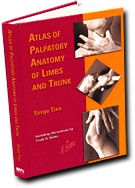|
|
Atlas of Palpatory Anatomy of Limbs and Trunk
Book Review by Steven Lavitan, DC, LAc
|
Title:
|
Atlas of Palpatory Anatomy of Limbs and Trunk
|
|
Author:
|
Serge Tixa; illustrations by Frank H. Netter
|
|
Publisher:
|
Saunders (Elsevier), 2003
|
|
Part #:
|
T-283
|
 This book is different from most others. It is not a classic anatomy book or an atlas of regional anatomy. Instead, it is an atlas of surface anatomy, written by an anatomy instructor from a Swiss osteopathic school, who had a great eye for detail, and with numerous illustrations by the pre-eminent medical artist of the 20th century, Frank Netter, MD. This book is different from most others. It is not a classic anatomy book or an atlas of regional anatomy. Instead, it is an atlas of surface anatomy, written by an anatomy instructor from a Swiss osteopathic school, who had a great eye for detail, and with numerous illustrations by the pre-eminent medical artist of the 20th century, Frank Netter, MD.
Each photograph is professionally done, with a relevant caption that sometimes has arrows and numbers to help clarify the underlying anatomical structures. Learning surface anatomy is important for students of chiropractic, acupuncture, physical therapy, and osteopathy (for those who manipulate), all of whom are unlikely to see "under the hood" of the average patient, so to speak. They have to mine the surface of the body by sight, and whatever they can palpate. Many of the plates have the patient doing isometric contractions in specific poses, or have the clinician compressing, stretching or pinching structures to enhance details.
The fact that Tixa chose not to include connecting prose (with the exception of the extensive captions) in Atlas of Palpatory Anatomy is both a strength and weakness. It makes the work concise, but at a cost: the data are somewhat discrete and almost digital. In the future, maybe a computer CD version or DVD would be a worthwhile accompaniment. It would be very effective if one could hypertext back and forth between the surface and regional anatomical depictions. It was a bit troublesome having to toggle back and forth between books.
Another small drawback is that the pictures are in black and white, with the exception of Netter's work. It creates a monotonous feeling, especially when viewing a series of pictures. Also, color coding would allow a more effective form of labeling. The little numbers used in labeling can be hard to see because they sometimes lack contrast. Additional detailed anatomical renderings might have clarified surface landmarks.
Despite these minor concerns, the concept behind the book and the overall presentation are impressive. For example, take the picture of Scarpa's (femoral) triangle. The base is formed by the inguinal ligament, the lateral border by the sartorius, the medial border by adductor longus, the apex by the junction of the sartorius and adductor longus, and the floor medially by the pectineus and laterally by the iliopsoas. The picture in the book makes it all stand out beautifully.
Atlas of Palpatory Anatomy of Limbs and Trunk is a useful reference for the clinician, but is arguably more important for students. It fits a peculiar niche that you may not have known was even there.
Dr. Lavitan's Rating:
 9
out of
10
9
out of
10
|

|








